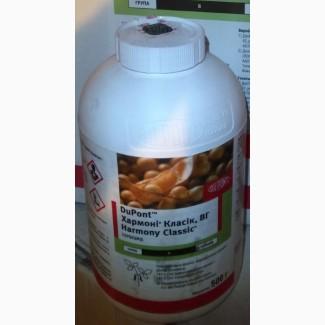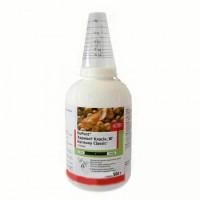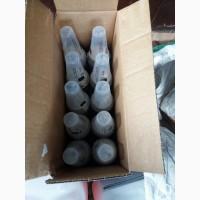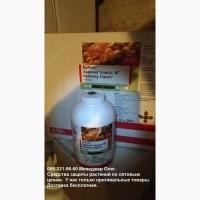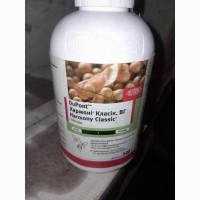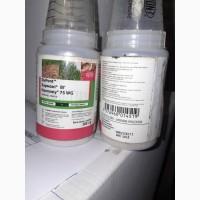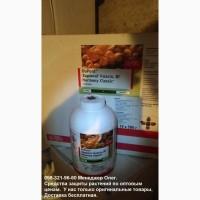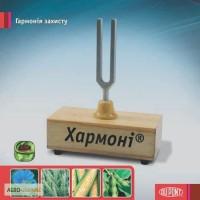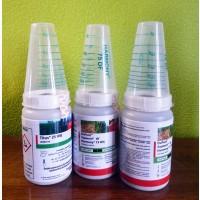/ Fertilizers and plant protection products / Herbicides / Harmony Classic - herbicide to protect soybeans from...
Sell / buy
Harmony Classic - herbicide to protect soybeans from a complex of weeds, Kyivska region.
Price135$
Region:all Ukraine,
Kyiv region.
(Vyshhorodok)
Updated:
Harmony® Classic - New post-emergence herbicide to protect soybeans from the most problematic types of dicotyledonous weeds.
Active ingredient: thifensulfuron-methyl - 187.5 g/kg, chlorimuron-ethyl -187.5 g/kg
Preparative form: water-soluble granules
Chemical class: sulfonylureas
Rate of use: 35 g/ha
Packaging: plastic can 500 g
Manufacturer: Du Pont
Application of Harmony Classic:
Culture - Consumption rate, g/ha - Application phase - Spectrum of action - Number of treatments per season
• Soy
- 35
- the appearance of the first trifoliate leaf in soybeans
- annual dioecious bottom weeds(//tractor-service.com)
- one
The main advantages of Harmony Classic on soybeans:
-intensified control of annual two-family lowland weeds, especially species of quinoa, netreba, styrica, bitterchak, common sedum, etc.;
- improved action against black nightshade, carrionsunflower andrape;
-capable of partially soil protective action against dicotyledonous weeds;
able to suppress types of grass weeds.
Harmony Classic is an updated concept of soybean post-emergence protection. Thanks to the combination of 2 active specialized substances, the drug provides improved and long-term control of an expanded spectrum of key, most problematic types of dicotyledonous weeds. This feature of the drug is especially appropriate when soybean is grown as a monoculture in wide-row crops.
Mechanism of action of Harmony Classic Harmony Classic is a systemic herbicide that combines two specialized active substances for soybeans that quickly enter the leaves and roots of weeds, providing foliar and partial soil action. The active substances of the drug block the enzyme ALS (acetolactate synthase), which stops the growth of plants of sensitive weed species a few hours after application.
Norms and terms of use: To achieve maximum effectiveness, it is recommended to use the drug in the early stages of actively growing weeds (cotyledons - 2 true leaves), optimally - at the appearance of the first shamrock in soybeans.
It must be used with the surfactant Trend® 90, in a concentration of 0.1-0.125%.
Spectrum of controlled weeds:
Sensitive weeds: Loboda, species Common wormwood, St. John's wort, Netreba, species Schirytsia, species Sunflower turnip, species Theophrastus sedge (opt. cotyledon - 1st pair of leaves) Bitter gourd Birch bittergourdMustard Field Radish Wild Chamomile, species Garden thistle Stinging nettle, types Field stiltbush Common sedge, species Common starwort Common sorrel Medicinal dry rib Medium-sensitive weeds Ragweed (opt. cotyledon - 1st pair of leaves) Pink thistle Garden purslane Field birch Hibiscus three-leaved Solanum black (opt. cotyledon - 1st pair of leaves) sheets)
Active ingredient: thifensulfuron-methyl - 187.5 g/kg, chlorimuron-ethyl -187.5 g/kg
Preparative form: water-soluble granules
Chemical class: sulfonylureas
Rate of use: 35 g/ha
Packaging: plastic can 500 g
Manufacturer: Du Pont
Application of Harmony Classic:
Culture - Consumption rate, g/ha - Application phase - Spectrum of action - Number of treatments per season
• Soy
- 35
- the appearance of the first trifoliate leaf in soybeans
- annual dioecious bottom weeds(//tractor-service.com)
- one
The main advantages of Harmony Classic on soybeans:
-intensified control of annual two-family lowland weeds, especially species of quinoa, netreba, styrica, bitterchak, common sedum, etc.;
- improved action against black nightshade, carrionsunflower andrape;
-capable of partially soil protective action against dicotyledonous weeds;
able to suppress types of grass weeds.
Harmony Classic is an updated concept of soybean post-emergence protection. Thanks to the combination of 2 active specialized substances, the drug provides improved and long-term control of an expanded spectrum of key, most problematic types of dicotyledonous weeds. This feature of the drug is especially appropriate when soybean is grown as a monoculture in wide-row crops.
Mechanism of action of Harmony Classic Harmony Classic is a systemic herbicide that combines two specialized active substances for soybeans that quickly enter the leaves and roots of weeds, providing foliar and partial soil action. The active substances of the drug block the enzyme ALS (acetolactate synthase), which stops the growth of plants of sensitive weed species a few hours after application.
Norms and terms of use: To achieve maximum effectiveness, it is recommended to use the drug in the early stages of actively growing weeds (cotyledons - 2 true leaves), optimally - at the appearance of the first shamrock in soybeans.
It must be used with the surfactant Trend® 90, in a concentration of 0.1-0.125%.
Spectrum of controlled weeds:
Sensitive weeds: Loboda, species Common wormwood, St. John's wort, Netreba, species Schirytsia, species Sunflower turnip, species Theophrastus sedge (opt. cotyledon - 1st pair of leaves) Bitter gourd Birch bittergourdMustard Field Radish Wild Chamomile, species Garden thistle Stinging nettle, types Field stiltbush Common sedge, species Common starwort Common sorrel Medicinal dry rib Medium-sensitive weeds Ragweed (opt. cotyledon - 1st pair of leaves) Pink thistle Garden purslane Field birch Hibiscus three-leaved Solanum black (opt. cotyledon - 1st pair of leaves) sheets)
|
Shop, contacts | |
Yuriy / feedback, info. / evaluation activities | |
|
Phone:
+38(xxxxxx
show
| |
All ads user ~1000 | |
Ad ID: #923815
(added by registered user, registration date: 2016-08-10)
Added / Updated: 10-15-2025 09:03 (current, until: 10-15-2026)
Permanent Ad Address:
Impressions / views for today: ?, total: ?
Similar ads
There are many interesting ones among them...
